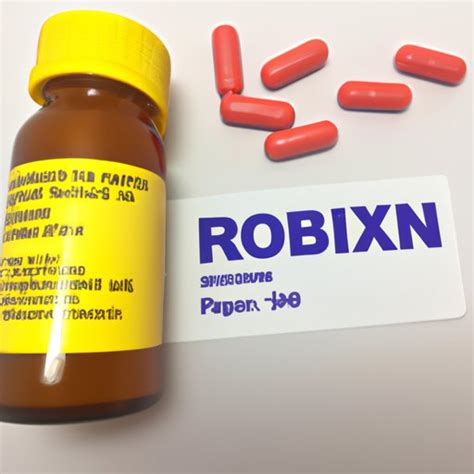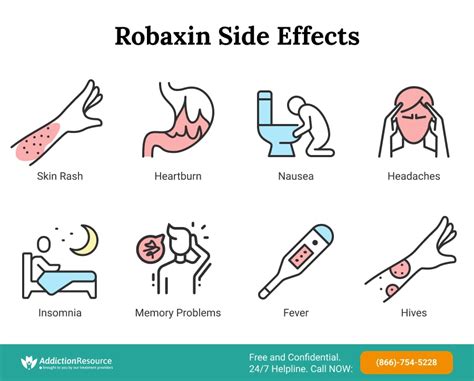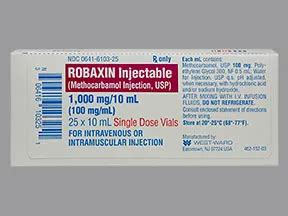Intro
Robaxin, also known as methocarbamol, is a muscle relaxant used to treat muscle spasms and pain. It is a centrally acting muscle relaxant, meaning it works by affecting the central nervous system to produce its therapeutic effects. Robaxin is commonly prescribed for the treatment of acute, painful musculoskeletal conditions, such as muscle strains, sprains, and spasms. The medication is available in tablet and injection forms, and it is typically taken orally or administered intravenously.
The importance of understanding Robaxin lies in its widespread use for managing muscle-related pain and discomfort. Muscle spasms and pain can significantly impact an individual's quality of life, making everyday activities challenging. By providing effective relief from these symptoms, Robaxin plays a crucial role in helping patients regain control over their daily lives. Furthermore, the medication's mechanism of action and potential side effects are essential aspects to consider for both healthcare professionals and patients.
The use of Robaxin has been a topic of interest in the medical community due to its efficacy in treating muscle spasms and pain. The medication's ability to provide quick relief from discomfort has made it a popular choice among healthcare providers. Additionally, the relatively low risk of serious side effects has contributed to its widespread adoption. However, as with any medication, it is crucial to understand the potential risks and benefits associated with Robaxin to ensure safe and effective use.
How Robaxin Works

Robaxin works by affecting the central nervous system, specifically the brain and spinal cord. The medication's exact mechanism of action is not fully understood, but it is believed to involve the inhibition of nerve impulses that transmit pain signals to the brain. By blocking these nerve impulses, Robaxin helps to reduce muscle spasms and relieve pain. The medication's effects are typically felt within 30 minutes of administration, and they can last for several hours.
The therapeutic effects of Robaxin are attributed to its ability to depress the central nervous system. This depression of the central nervous system leads to a reduction in the transmission of nerve impulses that cause muscle contractions and pain. As a result, Robaxin is effective in treating a range of muscle-related conditions, including muscle strains, sprains, and spasms. The medication's efficacy in providing quick relief from discomfort has made it a popular choice among healthcare providers.
Benefits of Robaxin
The benefits of Robaxin are numerous, and they include: * Rapid relief from muscle spasms and pain * Effective treatment of acute, painful musculoskeletal conditions * Low risk of serious side effects * Availability in tablet and injection forms * Centrally acting mechanism of action, which reduces the risk of addictionRobaxin's benefits are not limited to its therapeutic effects. The medication's relatively low risk of serious side effects has made it a popular choice among healthcare providers. Additionally, the availability of Robaxin in tablet and injection forms has increased its accessibility and convenience for patients.
Side Effects of Robaxin

Like any medication, Robaxin can cause side effects. The most common side effects of Robaxin include:
- Drowsiness
- Dizziness
- Headache
- Nausea
- Vomiting
- Abdominal pain
- Constipation
These side effects are typically mild and temporary, and they often resolve on their own within a few days of treatment. However, in some cases, Robaxin can cause more serious side effects, such as allergic reactions, seizures, and respiratory depression. It is essential to seek medical attention immediately if any of these serious side effects occur.
Precautions and Warnings
Robaxin is not suitable for everyone, and there are certain precautions and warnings to consider before taking the medication. These include: * Allergic reactions: Robaxin can cause allergic reactions, including anaphylaxis, which can be life-threatening. * Seizures: Robaxin can increase the risk of seizures, particularly in patients with a history of seizure disorders. * Respiratory depression: Robaxin can cause respiratory depression, which can be life-threatening in severe cases. * Pregnancy and breastfeeding: Robaxin should be used with caution in pregnant and breastfeeding women, as its effects on the fetus and baby are not fully understood.It is crucial to discuss these precautions and warnings with a healthcare provider before taking Robaxin. By understanding the potential risks and benefits associated with the medication, patients can make informed decisions about their treatment.
Interactions with Other Medications

Robaxin can interact with other medications, including:
- Sedatives and tranquilizers: Robaxin can increase the effects of sedatives and tranquilizers, leading to increased drowsiness and respiratory depression.
- Antihistamines: Robaxin can increase the effects of antihistamines, leading to increased drowsiness and dry mouth.
- Muscle relaxants: Robaxin can increase the effects of other muscle relaxants, leading to increased muscle weakness and respiratory depression.
It is essential to inform a healthcare provider about all medications being taken before starting Robaxin. By understanding the potential interactions between Robaxin and other medications, patients can minimize the risk of adverse effects.
Dosage and Administration
The dosage and administration of Robaxin vary depending on the individual patient and the condition being treated. The typical dosage of Robaxin is 1,500 mg to 3,000 mg per day, divided into 3 to 4 doses. The medication can be taken orally or administered intravenously.It is crucial to follow the dosage and administration instructions provided by a healthcare provider. Taking more than the recommended dose of Robaxin can increase the risk of adverse effects, while taking less than the recommended dose may reduce the medication's efficacy.
Conclusion and Final Thoughts

In conclusion, Robaxin is a muscle relaxant used to treat muscle spasms and pain. The medication works by affecting the central nervous system to produce its therapeutic effects. While Robaxin is generally well-tolerated, it can cause side effects, and there are certain precautions and warnings to consider before taking the medication. By understanding the potential risks and benefits associated with Robaxin, patients can make informed decisions about their treatment.
We invite you to share your thoughts and experiences with Robaxin in the comments section below. Have you taken Robaxin for muscle spasms or pain? What were your experiences with the medication? Share your story to help others understand the benefits and risks of Robaxin.
What is Robaxin used for?
+Robaxin is used to treat muscle spasms and pain. It is a centrally acting muscle relaxant that works by affecting the central nervous system to produce its therapeutic effects.
What are the common side effects of Robaxin?
+The most common side effects of Robaxin include drowsiness, dizziness, headache, nausea, vomiting, abdominal pain, and constipation. These side effects are typically mild and temporary, and they often resolve on their own within a few days of treatment.
Can Robaxin be taken with other medications?
+Robaxin can interact with other medications, including sedatives and tranquilizers, antihistamines, and muscle relaxants. It is essential to inform a healthcare provider about all medications being taken before starting Robaxin.
